
Spanish Tales for Beginners
Spain has a rich and varied literature, from which other nations have freely drawn,—a literature that gives true expression to the life and aspirations of the Spanish people. The selections in this volume are taken from literary works that have been written in the past fifty or sixty years, and although they are inferior in some respects to the great master-pieces of the sixteenth and seventeenth centuries, I believe that they have literary excellence, and they have, besides, the advantage of being written in the language of today and of describing present-day life. It is my greatest wish that this volume may awaken the students' interest in the civilization of Spain, and that it may serve as an introduction to the study of Spanish literature. The integrity of the texts has been preserved so far as the exigencies of a beginners' book permit, but the following changes have been made: (1) Some words or passages have been omitted, chiefly in the earlier stories. The parts thus omitted are, for the most part, digressions or uninteresting descriptive passages. Omissions have generally been marked by four suspensive points, or by three at the beginning of a story. Except at the beginning of a story, three suspensive points form a part of the punctuation of the several authors. (2) The orthography has been made to conform to that now prescribed by the Royal Spanish Academy. (3) In the earlier stories, le has been substituted for the feminine indirect object-pronoun la, and los for the masculine plural direct object-pronoun les. (4) And in the earlier stories, the conjunctive personal pronoun-object has been placed before the indicative verb: e.g., se tornó for tornóse, p. 11, l. 4. (5) The conjunction y has been added a few times to bridge over an omission: e.g., p. 2, l. 3. (6) In a few cases one word has been substituted for another: vieron for se apercibieron de que, p. 22, l. 11; la niña for la del rojo balandrán, p. 47, l. 13; Rogó for De esto á rogar, p. 48, l. 9; ese dinero for esos monises, p. 57, l. 31; cochero for auriga, p. 58, l. 4; reloj for calderómetro, p. 101, l. 7; otro pájaro for la escula-mata, p. 116, l. 9; madre for escula-mata, p. 116, l. 11. In the notes the difficulties have been explained, so far as possible, by reference to the vocabulary, or by rearranging the words; but it has often been necessary to translate into English. Perhaps the criticism will be made that the notes to the first few pages are too numerous and too simple; but many of these notes, and especially those that explain elementary rules of Spanish grammar, are given for the benefit of students who begin to read almost from the first. In the notes to the lyrics, no attempt has been made to treat Spanish prosody fully; only a few rules are given, and these in the simplest language
| Auteur | | Various Authors |
| Taal | | Spaans |
| Type | | E-book |
| Categorie | | Geschiedenis |





